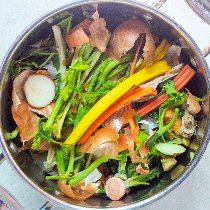
Ingredients:
This is not an exact recipe, but a kind of food-saving practice! As you prepare a meal, put clean skins, ends of vegetables and herbs that you will not use in a plastic bag or container in your freezer. In another container save bones to make vegetarian or meat flavored stock. For example:
skins and ends of allium, like onions, shallots, garlic, scallions and leeks, cobs of corn
ends and peels of root vegetables like carrots, parsnips, potatoes, beets
ends and leaves or fronds of stalks like celery, fennel and asparagus
stems of mushrooms
stems of herbs
cores of peppers
any whole vegetable versions of the above that are wilted, but not yet spoiled or moldy
other flavor enhancers: Parmesan rinds or seaweed such as kombu
avoid members of the Brassica family (cabbage, Brussels sprouts, broccoli, cauliflower, etc,) as those can make the stock bitter.
For meat stock, also add bones from chicken carcasses or ribs (raw or salvaged from the dinner table or whatever cheap bones you can get at the butcher and stashed in your meat scrap freezer container.
When there is enough to fill roughly half of your largest pot, make stock!
Note: If your recipe’s flavor relies on the stock, like soup or risotto, add some fresh vegetables, like a chopped onion and a couple of carrots to deepen and even out the flavor.
Directions:
Put all your scraps in a stock pot or large saucepan and add water until everything starts to float. Bring to a boil over high heat, then reduce to simmer. If you're using any meat, skim the surface of any foam. Simmer for a few hours, if possible or at least 30-45 minutes. Meat bones may take as long as 6 to 8 hours to release all their flavor.
Strain the stock through a fine-meshed sieve (cheesecloth or coffee filters work, too) and let cool.
Compost or discard the solids.
The stock will last for at least a week in the fridge and months in the freezer.
What to do with your stock? Make any kind of soup, use instead of water to cook rice or other grains for grain bowls, add to sauces, vegetable smoothies. Get creative.
Story:
Do you upcycle food in your kitchen to reduce food waste? It’s a discipline. Mei and Irene Li who provided the recipe and photo above and have lots of no waste strategies and recipes on their Food Waste Feast site and in their cookbook Perfectly Good Food.
Also, would you purchase delicious food products made from perfectly good farm surplus vegetables and fresh-cut veggie remnants? Whole Foods now sells delicious Italian tomato sauces made by Matriark Foods. Food banks have access to their healthy low sodium Navy Bean Stew and new products being developed as the small four-woman company grows its dream.
Matriark’s founder Anna Hammond spoke recently at the 35th annual Marbleseed Organic Farming Conference (formerly known as MOSES). Her story is inspiring. Farmers agree that it's good to donate surplus produce that they can’t sell. Matriark has found a way to create a business that can pay the farmer, provide jobs to those who manufacture delicious “upcycled” food products and make them available to food insecure folks and people of all income levels through retailers, hospitals, schools and food banks, even through distributors like Sysco. An interview with Matriark’s CEO Anna Hammond reveals her passion!
The Upcycled Food Association describes upcycled foods as “an ancient tradition (most indigenous and farm cultures did it) based on the philosophy of using all of what you have. It’s about doing more with less and elevating all food and its seemingly unusable by-products to their highest and best use. It is also about reducing food waste, by creating high quality, nutritious food products out of the nutrients that slip through the cracks of our current food system.”
We know that each year, roughly 33 million tons of perfectly healthy vegetables never make it to the table. That’s a waste of food, water, and greenhouse gases. It’s bad for farmers and the planet. Like some other upcycling companies, “Matriark is on a mission to reduce greenhouse gases, expand access to healthy food, and increase deliciousness.” We are “boldly changing food systems for the benefit of future generations.”
Upcycled foods will indicate which ingredients are upcycled on their labels and many include a certification logo. You might see upcycled foods like baking mixes, barley milk, liquor, crackers, cookies, snacks, nuts and even liquor in your local store. Don’t assume it is healthy before you read the label. And, you may want to be choosy to ensure that processing is kept to a minimum so you are eating foods as close to the way they were grown as possible!





Post a Comment